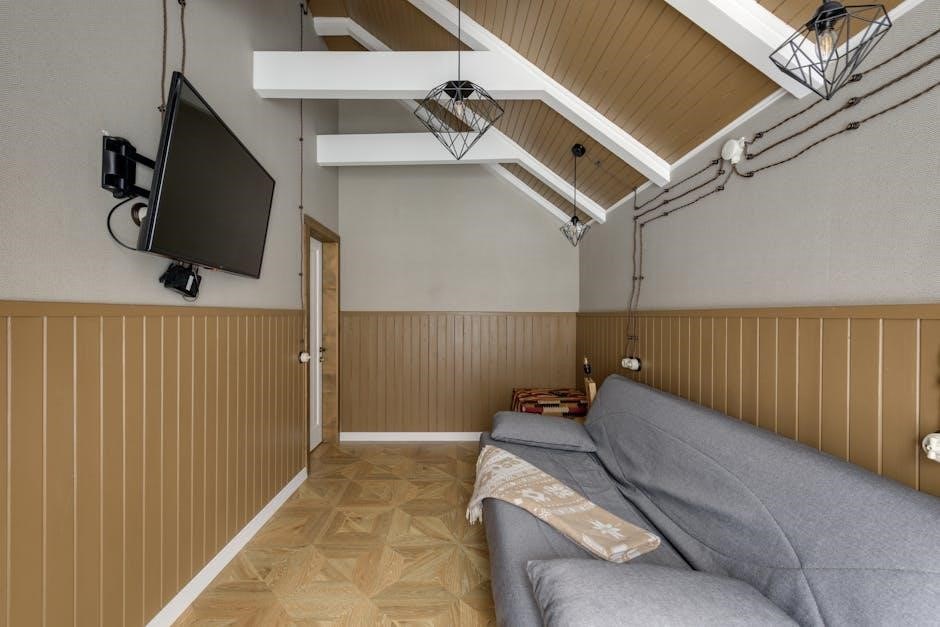Turner Classic Movies (TCM) is the premier destination for cinematic treasures, offering a curated selection of timeless films. This guide explores TCM’s programming, festivals, and special events, celebrating Hollywood’s golden era and beyond; Discover the magic of classic cinema with TCM’s expertly crafted schedule, ensuring timeless stories reach new generations.
1.1 Overview of Turner Classic Movies (TCM)
Turner Classic Movies (TCM) is a leading platform dedicated to preserving and showcasing classic cinema. Since its launch in 1994, TCM has become a trusted source for uncut, commercial-free screenings of iconic films. Known for its curated programming, TCM celebrates Hollywood’s golden era and beyond, offering a diverse range of genres and eras. The network is also recognized for its collaborations with industry legends and its commitment to film restoration.
TCM’s programming includes themed marathons, such as Godzilla movie marathons, and special events like the TCM Classic Film Festival. With a focus on storytelling and cinematic history, TCM continues to entertain and educate audiences worldwide.
1.2 Importance of TCM in Preserving Classic Cinema
TCM plays a vital role in preserving classic cinema by showcasing timeless films and ensuring their accessibility to new generations. Its commitment to unaltered, high-quality broadcasts helps maintain the integrity of cinematic history. Through collaborations with archives and restorations, TCM protects fragile film prints, preventing their loss. This dedication not only honors the artistry of the past but also fosters a deeper appreciation for cinema’s legacy among contemporary audiences.
1.3 What to Expect in This Article
This article delves into the world of Turner Classic Movies, offering a comprehensive guide to its programming, festivals, and special events. From the TCM Classic Film Festival to weekly highlights like Weekend Classic Westerns and Action Wednesdays, we explore the network’s dedication to preserving cinematic history. Additionally, we highlight special schedules, such as the Godzilla marathon and collaborations with industry legends like Guillermo del Toro. Discover how TCM enhances viewer experiences through technology upgrades and redesigned platforms, making classic cinema accessible to all.

TCM Classic Film Festival
The TCM Classic Film Festival is an annual celebration in Hollywood, honoring timeless movies and their creators, with screenings, panels, and notable guest appearances.
2.1 History of the TCM Classic Film Festival
The TCM Classic Film Festival, launched in 2010, has become a beloved event for cinema enthusiasts. It showcases iconic films, hosts legendary stars, and celebrates the art of filmmaking. The festival has honored figures like Peter O’Toole, Kim Novak, and Jane Fonda, making it a cornerstone of Hollywood’s cultural landscape.
2.2 Notable Guests and Honorees
The TCM Classic Film Festival has become a hotspot for film lovers and industry icons. Notable guests include directors like Michael Mann and Rob Reiner, along with actors such as Kathy Bates and Aaron Sorkin. The festival has also honored legends through its hand and footprint ceremony, celebrating stars like Peter O’Toole, Kim Novak, and Jane Fonda. These appearances and tributes highlight TCM’s commitment to celebrating cinematic history and the talent behind it, making the event unforgettable for attendees.
2.3 Special Screenings and Events
TCM’s festival offers exclusive screenings of restored classics, rare films, and behind-the-scenes insights. Panels with filmmakers and stars provide unique perspectives, while special ceremonies honor cinematic achievements. These events create a dynamic experience, blending nostalgia with contemporary appreciation for film artistry. Attendees gain access to one-of-a-kind moments that celebrate movies and their creators, making the festival a must-attend event for cinephiles seeking more than just screenings.

Weekly Programming Highlights
TCM offers themed weekly programming, featuring Weekend Classic Westerns on Saturdays and Sundays at 3pm, TCM Movies Essential Collection on Monday evenings, and Action Wednesdays midweek.
3.1 Weekend Classic Westerns
TCM’s Weekend Classic Westerns bring iconic cowboy tales to life every Saturday and Sunday at 3pm. Featuring legendary directors like John Ford and Clint Eastwood, these films showcase the rugged spirit of the Wild West. From timeless classics to lesser-known gems, this programming block celebrates the genre’s rich history. Audiences can enjoy unforgettable stories of heroism, adventure, and frontier life, making it a must-watch for both long-time fans and newcomers discovering the magic of Western cinema. TCM ensures these films remain accessible and engaging for all generations.
3.2 TCM Movies Essential Collection
The TCM Movies Essential Collection is a cornerstone of the network’s programming, showcasing a diverse range of films that define cinematic excellence. Every Monday evening, viewers can enjoy timeless classics, from iconic dramas to beloved comedies, carefully selected to highlight landmark achievements in filmmaking. This collection celebrates the artistry of legendary directors and stars, offering audiences a chance to revisit or discover films that have shaped the industry. With its curated selection, the Essential Collection remains a staple for both casual viewers and film enthusiasts alike.
3.3 Action Wednesdays
Action Wednesdays bring midweek excitement with a lineup of thrilling films that showcase gripping stories and unforgettable heroes. From classic westerns to espionage thrillers, TCM highlights iconic action-packed movies that keep viewers on the edge of their seats. This weekly feature celebrates the art of suspense and adventure, offering a diverse range of genres and eras. Whether it’s a swashbuckling epic or a noir detective tale, Action Wednesdays deliver cinematic thrills that cater to both action enthusiasts and film buffs alike. Catch these adrenaline-fueled classics every Wednesday night on TCM.

TCM Schedule Highlights
TCM’s schedule is a treasure trove of cinematic gems, featuring daily themes, premieres, and marathons. From timeless classics to rare screenings, every day offers something new and exciting for film enthusiasts.
4.1 Monthly Schedule Overview
TCM’s monthly schedule is thoughtfully curated to showcase a diverse range of films. Each month features themed programming, such as Westerns on weekends, essential collections on Mondays, and action-packed Wednesdays. Additionally, there are special marathons dedicated to iconic directors or genres. Viewers can also look forward to daily themes that highlight specific eras or movements in cinema. The schedule is updated regularly, ensuring a fresh and engaging lineup every month. This approach keeps the programming dynamic and appeals to both long-time classic film fans and new audiences.
4.2 Daily Themes and TCM Premieres
TCM’s daily themes offer a structured approach to cinematic exploration. Weekends feature Classic Westerns, while Mondays highlight films from the TCM Movies Essential Collection. Action Wednesdays bring thrilling midweek entertainment. Additionally, TCM Premieres introduce audiences to newly added classics, ensuring fresh content. The daily schedule often includes rare films and beloved favorites, catering to diverse tastes. This thematic approach enhances viewer engagement, making every day a unique cinematic journey. TCM’s commitment to variety and accessibility ensures there’s always something new to discover.
4.4 Special Movie Marathons
TCM regularly hosts special movie marathons, showcasing films around a central theme, genre, or director. These events are a highlight for cinema enthusiasts, offering a deep dive into specific eras or styles. For example, TCM’s Godzilla marathon in October 2025 celebrates the King of the Kaiju with 17 classic films. Such marathons often include rare screenings and introduced by experts, adding context and depth to the viewing experience.
These curated marathons are a unique way to explore cinematic history, making them a standout feature of TCM’s programming. They provide a concentrated celebration of film, catering to both casual viewers and dedicated cinephiles.

TCM’s Martin Luther King Jr. Day Schedule
TCM honors Martin Luther King Jr. Day with a thought-provoking lineup of films highlighting civil rights and social justice. The schedule features powerful stories and classic movies, inspiring reflection and conversation, while celebrating the legacy of Dr. King through timeless cinema.
5.1 Powerful Stories and Classic Films
TCM’s Martin Luther King Jr. Day schedule showcases films that highlight the struggles and triumphs of the civil rights movement. Classics like To Kill a Mockingbird, Guess Who’s Coming to Dinner, and In the Heat of the Night are featured, offering poignant reflections on racial inequality and social justice. These movies, directed by legends like Sidney Poitier and Stanley Kramer, emphasize moral courage and unity. Through these timeless stories, TCM honors Dr. King’s legacy, promoting equality and inspiring viewers to reflect on the ongoing journey toward justice and understanding.
5.2 Schedule Breakdown
TCM’s Martin Luther King Jr. Day schedule begins at 6:00 AM with To Kill a Mockingbird (1962), starring Gregory Peck. At 9:00 AM, Guess Who’s Coming to Dinner (1967) explores interracial relationships. In the Heat of the Night (1967) follows at 11:30 AM, featuring Sidney Poitier. The afternoon includes Roots (1977) at 2:00 PM, a powerful miniseries on slavery and freedom. A short documentary on Dr. King’s life airs at 5:00 PM, concluding with Do the Right Thing (1989) at 6:00 PM, reflecting on racial tensions and unity. This lineup honors Dr. King’s enduring impact through cinema.

Godzilla Movie Marathon
TCM’s Godzilla Movie Marathon celebrates the King of the Kaiju with classic films like Godzilla (1954) and Mothra vs. Godzilla (1964), showcasing iconic monster battles and enduring legacy.
6.1 Celebrating Godzilla’s Legacy
TCM’s Godzilla Movie Marathon honors the King of the Kaiju, showcasing his enduring impact on cinema. From the 1954 original Godzilla to Mothra vs. Godzilla (1964) and Ghidorah, the Three-Headed Monster (1964), these films highlight Godzilla’s evolution as a cultural icon. The marathon features special effects that revolutionized the genre and stories that blend monster battles with human drama. TCM’s tribute includes behind-the-scenes insights and interviews, celebrating Godzilla’s lasting influence on film and pop culture. This event is a must-watch for fans of classic monster movies and cinematic history.
6.2 List of Featured Films
TCM’s Godzilla Movie Marathon features a lineup of iconic films, including Godzilla (1954), Mothra vs. Godzilla (1964), and Ghidorah, the Three-Headed Monster (1964). The schedule also highlights Terror of Mechagodzilla (1975), showcasing Godzilla’s final battle in the Showa era. These films exemplify the evolution of the King of the Monsters, blending epic battles with compelling storytelling. The marathon offers a nostalgic journey through Godzilla’s cinematic history, celebrating its enduring legacy in global cinema.

TCM’s Technology Upgrade
TCM is enhancing viewer experience with a technology upgrade, offering improved HD streaming and a revamped app for better access to classic films and exclusive content.
7.1 Upcoming Changes and Improvements
TCM is currently undergoing a significant technology upgrade to enhance viewer experience. This includes improved HD streaming quality, a revamped mobile app, and a more user-friendly website interface. The upgrade aims to provide seamless access to classic films and exclusive content. While some disruptions may occur during the transition, the end result promises faster load times, better search functionality, and personalized recommendations. These changes reflect TCM’s commitment to preserving classic cinema while embracing modern technology to meet viewer demands.
7.2 Viewer Experience Enhancements
TCM’s technology upgrade focuses on elevating the viewer experience through enhanced features. The improved HD streaming ensures crisp, high-quality visuals, while the redesigned website offers intuitive navigation. A new mobile app allows seamless access to classic films on-the-go. Personalized recommendations based on viewing history help users discover hidden gems. Additionally, enhanced search functionality and an expanded on-demand library make it easier to explore TCM’s vast catalog. These upgrades aim to create a more engaging and accessible platform for film enthusiasts, blending tradition with modern convenience.

TCM’s Collaborations and Partnerships
TCM collaborates with institutions like American Cinematheque to celebrate cinematic milestones and showcases films handpicked by renowned directors like Guillermo del Toro, enriching its programming.
8.1 American Cinematheque Anniversary Tribute
TCM honored American Cinematheque’s 40th anniversary with a special triple feature, showcasing films curated by their staff. This collaboration celebrated the organization’s dedication to preserving and promoting cinematic heritage. The partnership highlighted TCM’s commitment to working with institutions that share its passion for classic cinema. The curated films reflected a diverse range of genres and eras, offering viewers a unique cinematic experience. This tribute not only celebrated American Cinematheque’s legacy but also reinforced TCM’s role as a leader in classic film preservation and programming.
8.2 Guillermo del Toro’s TCM Picks
Guillermo del Toro, the acclaimed filmmaker, collaborated with TCM to curate a selection of films that inspired his own work. His picks included classics from directors like Minnelli, Ford, and Ashby, showcasing a diverse range of cinematic styles. Del Toro highlighted “the most perfect action film ever made” among his choices, reflecting his admiration for both genre-defining and artistically groundbreaking cinema. This collaboration not only offered viewers a glimpse into del Toro’s influences but also demonstrated TCM’s ability to bridge generations of film enthusiasts through thoughtfully curated programming.

TCM Website Redesign
TCM’s website redesign introduces new features and improved navigation, enhancing user experience. The updated platform offers streamlined access to schedules, films, and exclusive content, making classic cinema exploration easier than ever.
9.1 New Features and Navigation
TCM’s redesigned website boasts enhanced navigation, allowing users to effortlessly explore schedules, films, and exclusive content. New features include improved search functionality, personalized recommendations, and a sleek, modern interface. The updated layout ensures quicker access to daily themes, premieres, and special events. Additionally, the site now offers a responsive design, providing an optimal viewing experience across all devices. These changes aim to make classic cinema more accessible and engaging for both long-time fans and new audiences alike.
9.2 Impact on User Experience
TCM’s website redesign significantly enhances user experience by streamlining navigation and improving accessibility. The updated interface allows viewers to easily discover films, check schedules, and explore exclusive content. Enhanced search features and personalized recommendations cater to individual preferences, making it simpler for audiences to find and enjoy classic cinema. Additionally, the responsive design ensures a seamless experience across devices. These improvements foster a deeper connection with TCM’s offerings, making classic films more accessible and engaging for both long-time fans and new viewers alike.

TCM Podcasts
TCM Podcasts offer engaging behind-the-scenes stories and in-depth analysis of classic films. From The Plot Thickens to exclusive interviews, these podcasts dive into cinema history, enriching the TCM experience for film enthusiasts.
10.1 The Plot Thickens: TCM’s Long-Form Podcast
The Plot Thickens is TCM’s captivating long-form podcast series, delving into the fascinating stories behind iconic films and filmmakers. Hosted by Ben Mankiewicz, it explores cinema’s most intriguing tales, featuring exclusive interviews and rare archival material. Each season focuses on a different theme or filmmaker, offering insights into Hollywood’s golden era and beyond. This podcast is a must-listen for film enthusiasts, providing a deeper understanding of the art and history of cinema.
10.2 Behind-the-Scenes Stories
TCM brings cinema to life with exclusive behind-the-scenes stories, offering rare insights into Hollywood’s most iconic films. From unseen footage to director commentaries, these stories reveal the craftsmanship and creativity behind classic movies. Interviews with filmmakers, actors, and industry experts provide a deeper understanding of cinematic history. TCM’s behind-the-scenes content highlights the challenges, triumphs, and secrets that shaped beloved films, making it a treasure trove for film enthusiasts and scholars alike.
TCM remains a vital advocate for classic cinema, preserving and celebrating timeless films. Its festivals, special programming, and behind-the-scenes insights ensure cinema’s legacy endures. Explore TCM’s offerings and rediscover Hollywood’s golden age through unforgettable stories and iconic movies.
11.1 Final Thoughts on TCM’s Role in Classic Cinema
TCM plays a pivotal role in preserving and celebrating classic cinema, ensuring that timeless films remain accessible to new generations. By showcasing a diverse range of cinematic masterpieces, TCM not only entertains but also educates audiences about the evolution of film. Its commitment to uncut and commercial-free presentations highlights the artistic integrity of classic movies. As a cultural archive, TCM fosters a deep appreciation for Hollywood’s golden era and beyond, making it an indispensable resource for film enthusiasts worldwide.
11.2 Encouragement to Explore TCM’s Offerings
TCM invites film enthusiasts to dive into its rich library of cinematic treasures. With a diverse lineup of classic films, special events, and insightful programming, there’s something for every movie lover. From iconic Hollywood epics to hidden gems, TCM’s schedule is designed to inspire discovery and nostalgia. By exploring TCM’s offerings, viewers can deepen their appreciation for the art of filmmaking and connect with the stories that have shaped cinematic history.






























